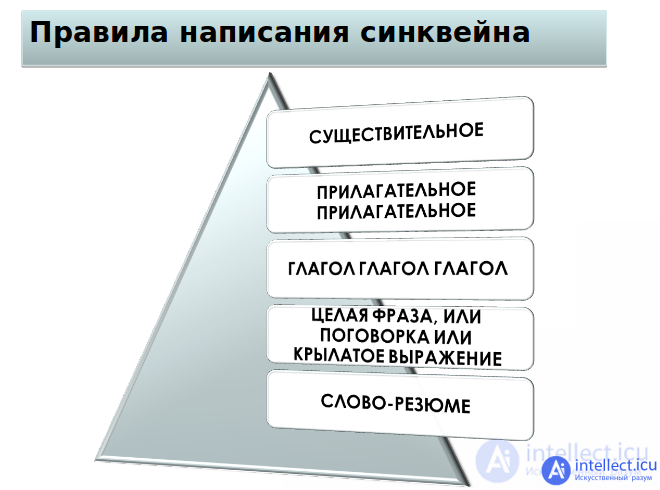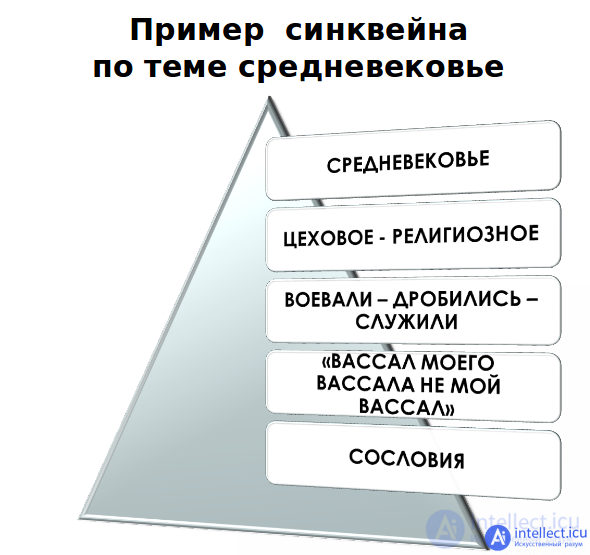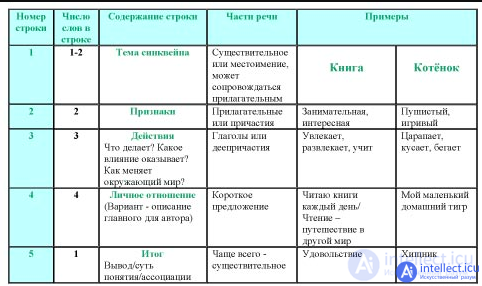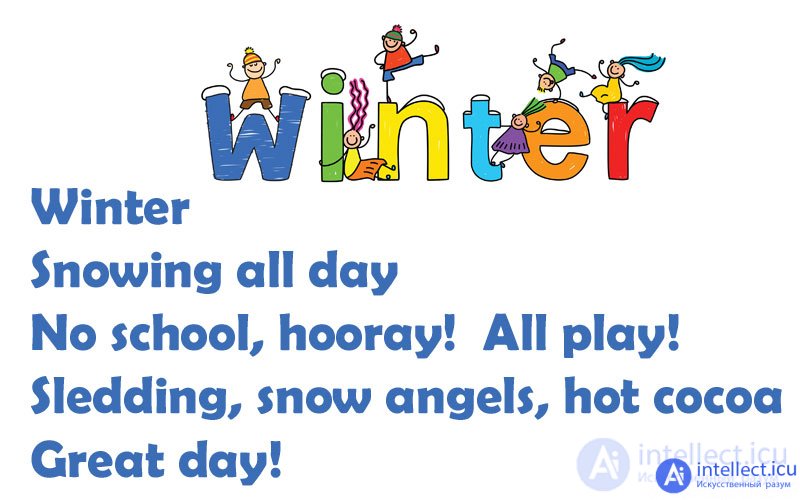Lecture
Sinkwain - methodical technique, which is a collection of verses of 5 lines. Moreover, the spelling of each of them is subject to certain principles, rules. Thus, there is a brief summary summarizing the study material. Sinkwain is one of the technologies of critical thinking that activates students' mental activity through reading and writing. Creating syncwap is free creativity, which requires the student to find and highlight the most important elements in the subject being studied, analyze them, draw conclusions and formulate briefly, based on the basic principles of writing a poem.
Cinquain is a class of poetic forms that use a 5 line pattern. Previously used to describe any five-line form, it now refers to one of several forms that are defined by specific rules and recommendations.
The modern form, known as American Sinkwain, originated on the basis of Japanese haiku and tank, similar to the spirit of the writer Imagist. In the work of 1915 under the name " Verse" , published a year after her death, Adelaide Crapsey had 28 Sinkweins.
The American form of Sincwain Crepes developed in two stages.
The first, fundamental form is a five-line stanza of an accented verse in which the lines contain, in order of 1, 2, 3, 4, and 1 stress.,
Then Crapsey decided to make the criterion a stanza of five lines of the stressed syllable verse, in which the lines contain, in order, 1, 2, 3, 4 and 1 stresses and 2, 4, 6, 8 and 2 syllables. ,
The iambic feet were to become the standard for cinquain, making the double criteria perfect. In some resource materials, classical synquains are defined as exclusively iambic, but this is not necessarily the case. Unlike the oriental forms on which she based them, Crapsey always named her syncwines, effectively using the name as the sixth line. Cincsean Crapsey depends on a strict structure and intense physical images to convey a mood or feeling.
The form is illustrated by Krapsi "November Night":
Listen ...
With a faint dry sound
Like the steps of passing ghosts
Frosty, crispy leaves fall from trees
And fall.
The Scottish poet William Southar also wrote more than a hundred American Sinkwains (he called them epigrams) between 1933 and 1940.
Cinquain Crapsey subsequently reviewed many changes by contemporary poets, including:
| variation | Description |
|---|---|
| Reverse Sincwain | a form with one stanza of 5 lines in a syllable scheme: two, eight, six, four, two. |
| Mirror Sincwain | a form with two 5-line stanzas consisting of cinquain followed by the reverse Sinquain. |
| Butterfly cinquain | a syllable form of nine lines with a pattern of two, four, six, eight, two, eight, six, four, two. |
| Crown of sincwain | a sequence of five Sinquain stanzas functioning to create one larger poem. |
| Garland Sinkwein | a series of six cinquains, in which the last consists of lines from the previous five, usually the first line from the first stanza, the second from the second stanza, and so on. |
Didactic cinquain is closely related to Crapsi cinvain. It is an informal syncwine that is widely taught in elementary schools and has been introduced and popularized by children's media resources, including Junie B. Jones and PBS Kids. Young people and older poets also take this form for its expressive simplicity. Recipes of this type of syncwine refer to the number of words, not to syllables and stresses.
Usually the first line is a one-word title, the theme of a poem;
the second line is a pair of adjectives describing this name;
the third line is a three-word phrase that gives more information about the subject (often a list of three verbs));
the fourth line consists of four words describing the feelings associated with this subject;
the fifth line is a synonym for one word or another reference to an item from the first line.
For instance:
Snow
Silent white
Dancing, falling, drifting
Covering everything with regard
Blanket
| the form | Description |
|---|---|
| tanka , "short song | represents a five-line form of Japanese poetry without rhythm, for a total of 31 morae, structured according to the scheme 5-7-5-7-7. |
| Tetraxis | It is a five-line poem of 20 syllables with a heading in the following order: 1, 2, 3, 4, 10, with each line standing as a separate phrase. It can be flipped, doubled, and so on. D. And was created by the English poet Ray Stebbings. |
| poem | is a five-line verse of five lines without a title with a syllabic structure of 1, 2, 3, 4, 1. Each line can usually stand on its own. |
It is believed that syncwine arose based on the principles of creating oriental poetic forms. Initially, great importance was attached to the number of syllables in each line, the arrangement of stresses. But in pedagogical practice all this is not paid much attention. The main emphasis is on the content and on the principles of constructing each of the lines.
When writing cinquain in didactic practice, slight deviations from the basic rules for writing it are allowed. So, for example, the number of words in one or several lines and the replacement of specified parts of speech with others can vary.
As an example, we give a poem compiled by children about this teaching method itself:
Cinquain
Imaginative, precise
Summarizes, develops, educates
"The power of speech lies in the ability to express a lot in a few words"
Creation.


The topic chosen for compiling the synquine should be close and interesting to students. The best results can be achieved if there is room for emotionality, sensuality.
Children are not always immediately involved in work. Difficulties can be associated with the need for analysis, understanding of the topic, lack of vocabulary, misunderstanding of certain terms, fear of mistakes. To help children, it is necessary to ask leading questions, expand their horizons, encourage any aspirations of students and answer emerging questions.
The main task of a teacher using the lesson method in a lesson is to think through a clear system of logically interconnected elements, the embodiment of which in images will allow students to understand and remember the material of the subject.
First you need to say that syncwine is a desire to briefly write down your knowledge, thoughts, feelings, emotions, associations, this is an opportunity to express your opinion on any issue, subject, event, phenomenon that will be the main theme of the work. Then you need to explain the basic rules for writing five passages; for clarity, give a few examples. And only after that the teacher announces the topic, indicating the time allotted for this work.
After the completion of the creative process, children read their poems at will. If the work took place, for example, as homework, the teacher can read out (or ask the author of the work to do this) the most interesting options. As an example, you can try to make one general synchronization by writing it on the board. Work in pairs or groups is allowed. But individual work is considered the most effective, because it allows the teacher to understand the depth of understanding of the material by each student
Sinkwine as a teaching method is universal. It can be applied to topics of any subject of the school curriculum. This allows students to show interest, helps to better understand and understand the material studied. Compiling a pentameter is quite simple, so its use is permissible when working with children of any age.
Sinkwine is a special poem that results from the analysis and synthesis of existing or just obtained data. It can be used at the test stage, when children, without even familiarizing themselves with the new topic, compose a poem based on the information that they currently know. This allows the teacher to understand what children already know about this problem, and will correct the information that must be passed on to the children so that they study the material correctly.
At the understanding stage, writing cinquain allows the teacher to evaluate how students understand the topic being studied, diversify the learning process and make it more interesting, because cinquain is also a game activity. In this case, the technique is a change in activity that contributes to some emotional unloading of students.
And it can be used at the stage of reflection. A thought translated into an image allows the teacher to appreciate the students' understanding of the material being studied. Sinkwine is a fast but very powerful reflection tool.
Compiling a sinhwin is a creative activity and is more often used in the study of the humanities - literature, history. But to diversify the educational process, to make it more interesting, you can use this technique, for example, in physics lessons. Acquainted with the theme of Light, the teacher offers the children to compose Sinkwein.
Shine
Answer using adjectives, what is it? Bright warm
Tell me, using verbs, what does he do? Burns, burns, flickers.
Make a sentence or phrase that expresses an attitude to the topic and is a kind of conclusion. Need for people.
To summarize in one word. Radiance.
In nature science, you can invite children to write poems about time for.
Summer
Roast, fun
Walk, play, relax.
I expect as soon as possible.
Vacation!
Spring
Warm, bright, blooming
It blooms, turns green, smells.
Nature wakes up.
Cool!
In addition to the traditional compilation of syncwine, other types of work with the five verses of the lesson are possible.
Compose a story based on a finished poem. When compiling it is recommended to use the words and phrases used in this syncwine.
Edit the finished syncwine to improve it.
Add syncwine. To do this, you need to analyze this poem, identify the missing part and fill it out. For example, you can suggest a poem in which the topic is not indicated. Using the words characterizing and revealing it, students should understand what is at stake:
Fleeting freezing
Runs, stops, heals
Amazing phenomenon
A life.
Children must determine that the theme of this syncwine is Time .
Composing syncwine in a lesson takes relatively little time, but it is an effective way to develop figurative speech, which helps to quickly get a result.
In the course of work on this technique, students can not only deepen their knowledge on any topic, but also improve their ability to work independently with additional sources of information, plan their educational activities.
In the lessons of the exact sciences, you can invite children to compose synquains about the seasons.
Summer
Roast, fun
Walk, play, relax.
Look forward to.
Vacation!
Spring
Warm, bright
It blooms, turns green, pleases.
Nature comes to life.
Cool!
In a literature lesson, a teacher, for independent work, you can invite children to create a sincwain about their favorite work.
The result could be like this:
Girl
Smart and daring.
Travels, friends, wins.
I am thrilled with her !.
We are talking about the book “Girl of the Sixth Moon” by Mooney Witcher.
You can invite children to write a synquane about the sun:
The sun
Bright, distant
He warms, shines, pleases everyone.
I like the sun.
Life-giving star.
Sinkwain is an analysis and synthesis of information, a pun. This is poetry that promotes creative self-development and beautiful expression of one’s thoughts. This is a way of writing original and beautiful poems. That is why cinquain, as a method of training, is becoming increasingly popular and is increasingly being used in the educational process.


Share a
Comments
To leave a comment
Pedagogy and didactics
Terms: Pedagogy and didactics